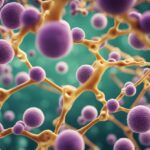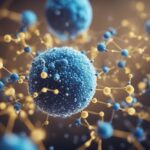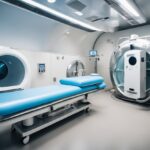Hyperbaric oxygen therapy (HBOT) has been used for decades to treat various medical conditions, including decompression sickness, carbon monoxide poisoning, and wound healing. Recently, there has been growing interest in the use of HBOT for anti-aging purposes. Proponents of HBOT for anti-aging claim that it can improve skin quality, reduce wrinkles, and promote general well-being.

HBOT involves breathing pure oxygen in a pressurized chamber, which increases the amount of oxygen in the blood and tissues. This increase in oxygen can stimulate the production of collagen, a protein that gives skin its elasticity, and promote the growth of new blood vessels, which can improve circulation. Additionally, HBOT can reduce inflammation, which is thought to be a key factor in the aging process.
While there is limited clinical evidence to support the use of HBOT for anti-aging, some studies have shown promising results. However, it is important to note that HBOT is not a miracle cure for aging and should not be used as a substitute for a healthy lifestyle. In this article, we will explore the fundamentals of HBOT, the mechanisms of anti-aging, clinical evidence of efficacy, treatment protocols, comparison with conventional anti-aging treatments, patient experiences and testimonials, regulatory and legal considerations, advancements and research trends, and frequently asked questions related to HBOT for anti-aging.
Key Takeaways
- HBOT is a pressurized treatment that involves breathing pure oxygen, which can stimulate the production of collagen, promote the growth of new blood vessels, and reduce inflammation.
- While there is limited clinical evidence to support the use of HBOT for anti-aging, some studies have shown promising results.
- HBOT should not be used as a substitute for a healthy lifestyle and should be used in conjunction with other anti-aging treatments.
Fundamentals of Hyperbaric Oxygen Therapy
Principles of Hyperbaric Medicine
Hyperbaric Oxygen Therapy (HBOT) involves the administration of 100% oxygen at a pressure greater than atmospheric pressure. The increased pressure allows for greater oxygen delivery to tissues, which can promote healing and improve various medical conditions.
Oxygen Under Pressure
Under normal atmospheric conditions, oxygen is transported throughout the body by binding to hemoglobin in red blood cells. However, when oxygen is delivered under pressure, it dissolves in the plasma and can be transported to areas of the body where red blood cells may not be able to reach. This can be beneficial for conditions such as wound healing, where increased oxygen delivery can promote tissue regeneration.
History of Hyperbaric Treatments
Hyperbaric treatments have been used for centuries, with the first documented use dating back to the 1600s. However, it wasn’t until the 20th century that hyperbaric treatments began to be used more widely in medical practice. Today, hyperbaric treatments are used for a variety of conditions, including decompression sickness, carbon monoxide poisoning, and diabetic wounds.
Overall, HBOT has shown promising results in promoting healing and improving various medical conditions. However, further research is needed to fully understand the mechanisms of action and potential benefits of this therapy.
Mechanisms of Anti-Aging
Cellular Oxygenation
Hyperbaric oxygen therapy (HBOT) has been shown to increase the concentration of oxygen in the body’s tissues, including the skin. This increased oxygenation can lead to improved cellular metabolism and function, which can help to slow the aging process. When cells are properly oxygenated, they are better able to produce energy and repair damage.
Reduction of Oxidative Stress
Oxidative stress is a major contributor to the aging process. It occurs when there is an imbalance between the production of free radicals and the body’s ability to neutralize them. HBOT has been shown to reduce oxidative stress by increasing the body’s production of antioxidants, which neutralize free radicals. This can help to protect the body’s cells from damage and slow the aging process.
Stimulation of Collagen Production
Collagen is a protein that is essential for healthy skin. It provides structure and elasticity, and helps to keep skin looking youthful. HBOT has been shown to stimulate the production of collagen in the skin, which can help to reduce the appearance of fine lines and wrinkles. This increased collagen production can also help to improve skin texture and tone.
Overall, HBOT has several mechanisms of action that can help to slow the aging process. By improving cellular oxygenation, reducing oxidative stress, and stimulating collagen production, HBOT can help to keep skin looking youthful and healthy.
Clinical Evidence of Efficacy

Peer-Reviewed Studies
Several peer-reviewed studies have provided evidence for the efficacy of hyperbaric oxygen therapy (HBOT) in anti-aging. One study published in the journal Rejuvenation Research found that HBOT was effective in reducing oxidative stress and inflammation, which are two major factors contributing to aging. The study also reported that HBOT improved cognitive function and physical performance in older adults.
Another study published in the Journal of Cosmetic Dermatology found that HBOT improved skin elasticity and reduced the appearance of wrinkles in patients. The study reported that HBOT increased collagen production, which is essential for maintaining youthful skin.
Patient Outcome Analysis
In addition to peer-reviewed studies, patient outcome analysis has also provided evidence for the efficacy of HBOT in anti-aging. A survey of patients who underwent HBOT for anti-aging purposes reported high satisfaction rates and improvement in various aspects of aging, including skin health, cognitive function, and physical performance.
Overall, the clinical evidence suggests that HBOT is a promising therapy for anti-aging. However, further research is needed to fully understand the mechanisms behind its effectiveness and to determine the optimal treatment protocol for different age groups and conditions.
Treatment Protocols
Session Duration and Frequency
Hyperbaric oxygen therapy (HBOT) is a non-invasive treatment that involves breathing pure oxygen in a pressurized chamber. The treatment has been shown to have anti-aging benefits by increasing oxygen supply to the body’s tissues, which can help to reduce inflammation and promote tissue repair.
The duration and frequency of HBOT sessions can vary depending on the individual’s needs and the condition being treated. Typically, a single session lasts between 60 and 90 minutes, but some individuals may benefit from longer sessions. The frequency of sessions can also vary, with some individuals undergoing daily treatments for several weeks, while others may only require occasional sessions.
Safety Procedures and Contraindications
While HBOT is generally considered safe, there are some safety procedures and contraindications that should be considered before undergoing treatment. Individuals with certain medical conditions, such as lung disease or heart problems, may not be suitable candidates for HBOT. Additionally, there are some potential risks associated with the treatment, such as ear pain or changes in vision.
Before undergoing HBOT, individuals should consult with a qualified healthcare professional to determine if the treatment is appropriate for their needs. During the treatment, safety procedures should be followed, such as monitoring oxygen levels and ensuring that the chamber is properly pressurized.
Overall, HBOT is a promising treatment option for individuals seeking anti-aging benefits. By following proper treatment protocols and safety procedures, individuals can safely and effectively reap the benefits of this innovative therapy.
Comparison with Conventional Anti-Aging Treatments

Hyperbaric oxygen therapy (HBOT) is a relatively new treatment for anti-aging, and as such, it is often compared to more traditional anti-aging treatments. Here, we will compare HBOT to three of the most common conventional anti-aging treatments: topical agents, surgical interventions, and lifestyle and dietary changes.
Topical Agents
Topical agents are a popular choice for anti-aging treatment. These agents include creams, serums, and lotions that are applied directly to the skin. They often contain ingredients such as retinoids, antioxidants, and peptides.
While topical agents can be effective in reducing the appearance of fine lines and wrinkles, they do not address the underlying causes of aging. Additionally, topical agents can be expensive and require ongoing use to maintain results.
Surgical Interventions
Surgical interventions, such as facelifts and eyelid surgery, are often used to address more severe signs of aging. These procedures involve removing excess skin and tightening the underlying muscles.
While surgical interventions can produce dramatic results, they are invasive and carry risks such as infection, scarring, and anesthesia complications. Additionally, surgical interventions can be expensive and require significant downtime for recovery.
Lifestyle and Dietary Changes
Lifestyle and dietary changes are often recommended as a way to slow the aging process. These changes can include exercise, a healthy diet, stress reduction, and adequate sleep.
While lifestyle and dietary changes can have a positive impact on overall health and well-being, they may not produce significant anti-aging results on their own. Additionally, these changes can be difficult to maintain and may not be effective for everyone.
Overall, while conventional anti-aging treatments can be effective in reducing the signs of aging, they may not address the underlying causes of aging or produce long-lasting results. HBOT, on the other hand, has been shown to address the root causes of aging at the cellular level, leading to more significant and long-lasting results.
Patient Experiences and Testimonials

Hyperbaric oxygen therapy has been gaining popularity as an anti-aging treatment in recent years. Patients have reported positive experiences and benefits from this therapy. Here are some testimonials from patients who have undergone hyperbaric oxygen therapy:
- “I have been undergoing hyperbaric oxygen therapy for a few months now and I have noticed a significant improvement in my skin texture and complexion. My skin looks more youthful and radiant than ever before.” – Sarah, 45
- “Hyperbaric oxygen therapy has helped me with my joint pain and stiffness. I feel more mobile and flexible now. It has also improved my energy levels and mental clarity.” – John, 60
- “I have been undergoing hyperbaric oxygen therapy for my chronic migraines and I have seen a significant reduction in the frequency and intensity of my headaches. It has also improved my sleep quality and overall well-being.” – Emily, 35
Hyperbaric oxygen therapy has been found to be safe and effective in treating various medical conditions. However, it is important to consult a healthcare professional before undergoing this therapy.
Regulatory and Legal Considerations
FDA Approvals
Hyperbaric oxygen therapy (HBOT) is a medical treatment that involves breathing pure oxygen in a pressurized chamber. Although HBOT has been used for decades to treat various medical conditions, it has not been approved by the U.S. Food and Drug Administration (FDA) for anti-aging purposes.
The FDA has approved HBOT for the treatment of certain medical conditions, such as decompression sickness, carbon monoxide poisoning, and non-healing wounds. However, the agency has not approved HBOT for anti-aging purposes, and it is illegal for companies to market HBOT as an anti-aging treatment.
Medical Practice Regulations
HBOT is considered a medical treatment, and as such, it is subject to regulations governing medical practice. In the United States, medical practice is regulated by state medical boards, which set standards for the practice of medicine and enforce those standards through disciplinary actions.
Physicians who offer HBOT for anti-aging purposes must comply with the regulations of their state medical board. These regulations may include requirements for physician licensure, informed consent, and medical record keeping.
In addition, physicians who offer HBOT for anti-aging purposes must ensure that their practice complies with federal laws and regulations, such as those related to medical billing and coding, patient privacy, and fraud and abuse.
Overall, physicians who offer HBOT for anti-aging purposes must ensure that their practice is in compliance with all applicable laws and regulations. Failure to comply with these regulations can result in disciplinary action by the state medical board, as well as legal liability for the physician and their practice.
Advancements and Research Trends
Innovations in Hyperbaric Technology
Hyperbaric oxygen therapy (HBOT) has come a long way since its inception. Innovations in technology have made it possible to administer HBOT in a more comfortable and efficient manner. For instance, the latest hyperbaric chambers are equipped with comfortable seating arrangements, temperature control systems, and entertainment options such as TV, music, and Wi-Fi. These features make the therapy more tolerable for patients, especially those who require multiple sessions.
Another significant innovation is the use of portable hyperbaric chambers. These chambers are designed to be used at home, making the treatment more accessible and convenient. Portable chambers are also helpful for patients who cannot travel to a hospital or clinic due to mobility issues or other medical conditions.
Future Directions in Anti-Aging Research
Recent research has shown promising results in the use of HBOT for anti-aging purposes. The therapy has been found to increase the production of stem cells, which can help repair damaged tissues and promote the growth of new cells. This can potentially reverse the aging process and improve overall health.
Studies have also shown that HBOT can improve cognitive function and memory in older adults. This is because the therapy increases blood flow and oxygen delivery to the brain, which can help prevent age-related cognitive decline.
In the future, researchers aim to explore the potential of HBOT for other age-related conditions such as osteoporosis, arthritis, and vision loss. They also plan to investigate the long-term effects of the therapy on overall health and quality of life.
Overall, advancements in hyperbaric technology and ongoing research in anti-aging show promising potential for the use of HBOT as a safe and effective treatment option.
Frequently Asked Questions
What are the potential benefits of hyperbaric oxygen therapy for skin rejuvenation?
Hyperbaric oxygen therapy can potentially increase collagen production, improve skin elasticity, and reduce the appearance of fine lines and wrinkles. It may also help with skin conditions such as acne, rosacea, and eczema.
How much does hyperbaric oxygen therapy typically cost when used for anti-aging purposes?
The cost of hyperbaric oxygen therapy for anti-aging purposes varies depending on the location, the number of sessions, and the specific clinic or provider. On average, a single session can cost anywhere from $100 to $300.
What is the recommended frequency of hyperbaric oxygen therapy sessions for anti-aging effects?
The recommended frequency of hyperbaric oxygen therapy sessions for anti-aging effects varies depending on the individual and their specific needs. Typically, a series of 10-20 sessions is recommended, with sessions occurring 2-3 times per week.
Are there any before and after studies that showcase the anti-aging effects of hyperbaric oxygen therapy?
While there have been some studies on the potential anti-aging effects of hyperbaric oxygen therapy, more research is needed to fully understand its effectiveness. Some before and after studies have shown improvements in skin texture, elasticity, and hydration.
How long can one expect the anti-aging effects of hyperbaric oxygen therapy to last?
The duration of the anti-aging effects of hyperbaric oxygen therapy varies depending on the individual and their specific needs. It is recommended to continue maintenance sessions every few months to help maintain the results.
What are the contraindications for undergoing hyperbaric oxygen therapy for anti-aging?
Hyperbaric oxygen therapy may not be suitable for individuals with certain medical conditions, such as lung disease, congestive heart failure, and seizures. It is important to consult with a healthcare provider before undergoing hyperbaric oxygen therapy.










